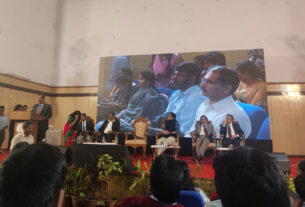Due to sudden change in climate, the local farmers are in doubt on how to save their crops from getting destroyed.
By Rohit Chatterjee
Bengaluru, Jan.31, 2019. The sudden change in climate due to global warming has affected the crops. Rice, Ragi, and Bajra are prominently grown in the areas surrounding Bengaluru. Rice needs an average temperature between 16 and 27 degrees Celsius, whereas Ragi grows in an average temperature of 27 degrees.
The temperature in the city has risen significantly over the years. Earlier, it used to linger between 21 and 32 degrees Celsius. However, the temperature went up to 34.6 degrees Celsius in 2011 and to 36.5 degrees in 2015.
There is a high probability that the temperature will rise again and will affect crops.
While talking to the Softcopy newspaper, a local farmer said, “The temperature is fine for now but we are just in the month of January, which falls under the winter season. The daytime temperature is somewhere between 19 and 21 degrees Celsius. I wonder how much it will rise in the summer season. It is a matter of concern since Ragi crops will not survive if the temperature goes above 30 degrees. The climate change will also affect the rainfall.”
To understand the aesthetics of agriculture, the Softcopy newspaper team spoke to the head of the department of Soil Science and Agricultural Chemistry, and Priyankar Raha explained the situation saying,” The climate change has indeed affected the crops. The crop requires a certain amount of water, if it does not receive it then there could be insects or fungi attack.
The crop has its’ own physiology that needs to be maintained constantly for which a typical climate is needed. Without the climate, the production of seed will be less. For example, the weight of 100 seeds could be 60 grams but due to abnormal climate, it might weigh only 48 grams.
Rainfall is one of the most important factors. The amount of water plays a major role so the water cannot be too much or too less. If there is too much rainfall, the crops will get flooded. Again if it is less, a problematic situation will arise.
There are ways to curb it such as climate-smart irrigation. If there is too much rain, the height of the farmland needs to be increased and a drain needs to be created. This will help the excessive water to flow down and the land will not be flooded.
In case of no rainfall, drip irrigation can be used. In this process, water pipes can be created below the soil which will provide little water but at a regular time so that the crop can soak it as per its need. The climate smart irrigation is the new way to save the crops from such climatic abnormalities.”
The climate smart irrigation could be costly, but to help the farmers, many government and cooperative banks are giving out loans. The loans are only provided for the crops which are majorly grown in a particular state or region.
Nowadays, crops are being produced with different variation. Rice and wheat have different varieties which can withstand abnormal climate.
Priyankar Raha added that there are different institutes in Cuttack, Karnal for example, where research is being done to produce new varieties of a crop.
Akshay Heblikar, an environmentalist gives an insight on the abnormal climatic change by saying, “We know the harms being done to nature. Deforestation, rapid construction, increase in vehicles etc, are the reasons. It is a matter of concern and people need to take steps because we are just inviting our destruction. The nature has lost its balance. It is affecting everything, be it crops or the glaciers.”





